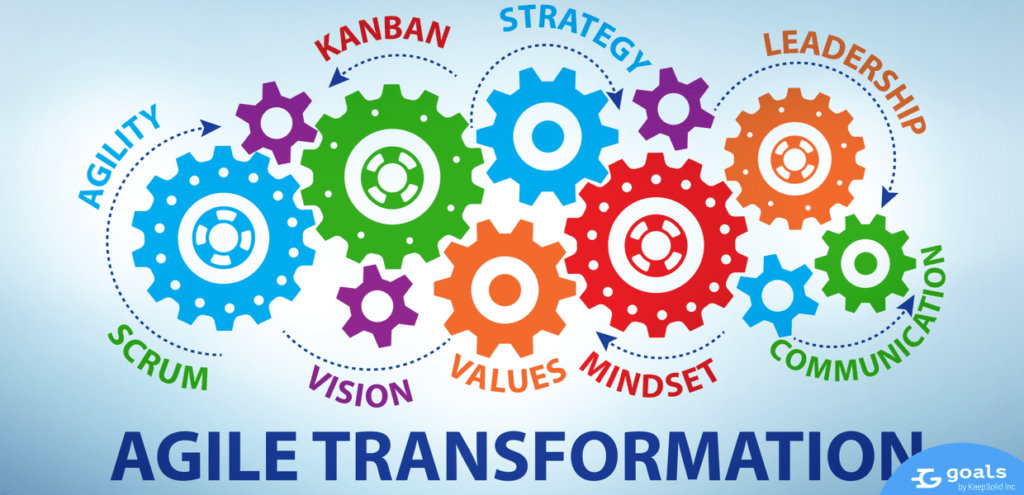
Agile Transformation
What is Agile Transformation?
The act of gradually converting an organization’s shape or nature to one that can embrace and prosper in a flexible, collaborative, self-organizing, fast-changing environment is defined as agile transformation.
When a company fully adopts an Agile methodology, it is said to have undergone Agile transformation. This transformation is not restricted to product development teams; for a firm to be genuinely Agile, every employee in every department must embrace the Agile Manifesto’s ideals and principles. This requires a willingness to be more adaptable and responsive, as well as successful collaboration and open communication.
A full Agile transformation would touch the four essential components of the organization, according to management consulting firm McKinsey & Company: people, processes, technology, and structure. It will also ensure that the company takes an iterative development strategy, which means that tasks are repeated in cycles until the best result is obtained.
Agile Transforming Organization
Agile organizations are distinct. Agile organizations are characterized by a network of teams operating in rapid learning and decision-making cycles. Traditional companies put their governance bodies at the top and delegate decision-making authority down the line; agile organizations, on the other hand, instead of a shared purpose, use new data to delegate decision-making authority to the teams closest to the information.
Agile Transforming Operating Model
Some businesses are built to be agile from the outset, with an Agile operating model. In terms of others, we see three types of agile journeys: All-in, which comprises an organization-wide commitment to become agile and several waves of agile transformation; Step-wise, which is more systematic and discrete; and Emergent, which is essentially a bottom-up approach. In the technology industry, born-agile organizations are fairly frequent.
Blueprint
The blueprint for an agile operating model must provide a clear vision and concept of how a new operating model may work, and it must be much more than an organization chart. Because an agile transformation significantly alters how work is done, blueprinting must also identify changes to the operating model’s people, processes, and technology elements. At first, the blueprint should be a minimum viable product (MVP) built in a fast-paced, iterative way that offers the company enough direction to begin testing the design.
The first stage in the blueprinting process is to figure out where the value is. All operating-model designs must be based on an understanding of how value is created in the industry as well as how value is created within the individual firm. This is inextricably linked to strategy.
The Benefit Of Agile Transformation
Many sectors have praised the advantages of Agile business transformation. Microsoft is only one example of a company that has successfully transitioned to an Agile attitude, abandoning the top-down management approach in favor of empowering teams.
The advantages of Agile have previously been explored, including flexibility, predictability, customer satisfaction, high-quality products, reduced risks, and enhanced communication. Here are some further advantages that Agile transformation can provide:
Return On Investment
A higher return on investment (ROI) is one of the most appealing aspects of Agile transformation. Agile organizations are more efficient, focusing primarily on initiatives that provide return on investment. They monitor performance and appraise projects regularly, removing those areas that do not provide actual value. Lean project management ideas, which involve eliminating waste areas to reduce costs, are frequently incorporated into agile transformations. Customer feedback is also included in the development process by agile teams to guarantee that the final deliverables meet their requirements. As a result, customer retention and profitability are improved. Though Agile transformation has a lot of potential benefits, it also has a lot of drawbacks if not properly followed.
The Five Steps to Build an Agile Delivery Model
1. Align your technology with your company’s capabilities.
Modeling the technological environment based on how technology is utilized by product or business capabilities is known as product alignment or productization. Technology may be matched to phases of a customer journey, where steps in a business process, business value streams, business units/segments, or other segmentation approaches, are done in collaboration with key business stakeholders (whether financially, operationally, or functionally). As a result, a portfolio of products is created, which is frequently organized into product families of coupled or highly dependent products. The critical determinant has to do with the business stakeholders or user constituency to ensure that requirements and priorities are aligned and owned.
2. Leaders in Business and Technology should be identified.
Build a culture that aligns IT and the business to show the enterprise that IT is focused on delivering to the business in a new way. Complementary business and technology leaders should be identified as part of this alignment. Reduce pointing fingers and instead take collaborative responsibility for problems and their resolution, as well as joint accountability for product capabilities. By aligning technology goods and services with company ownership, you may focus on the business’s goals and priorities while also managing essential technical demands, such as technical debt, with a two-in-one approach. This step should also include the definition of goals.
To properly implement agility into an organization, the business and technology owners must set clear and precise objectives that will keep agile teams in sync and allow them to stay focused on the components of delivery that support the business’s goals. This is a crucial commercial partnership. Only if the team’s aims and objectives are supported and aligned with the company’s goals and objectives will they be able to measure success or failure. Before forming the teams, involvement of business owners communicating to employees and management that the company values objective feedback is crucial. The feedback should be incorporated into how Business and IT leaders assess the performance of their agile delivery efforts.
3. Begin small and work your way up.
Use an agile team model based on the “minimum viable product” (MVP), which includes a defined governance approach (standards, oversight, and best practices) as well as a performance framework that describes how teams will be measured. Use this “light,” MVP-level strategy for initial implementation; the hope is that as teams develop and mature, they will uncover impediments and find solutions that will allow the model to evolve.
To begin, form a small group of teams and assign team members based on the talent mix and objectives for that product or capability. Focus on team composition when clear objectives have been established and the business has been engaged. The agile team should be made up of people from several departments. People from the business, technological, infrastructural, and architecture units will come together to form new viewpoints.
4. Create a team and work to improve it regularly.
Engage the agile teams and ensure that the current model and product-specific goals are communicated. Launch the procedures needed to complete the work, outputs, and deliverables following the company’s priorities. Allow enough time for the team to examine its current state: what are the competence level of the team and its members? What are the product’s performance objectives? Is the team’s and the company’s culture supportive of team empowerment and collaboration? What kind of education (and practice) is required to develop agile skills? If talking about change is seen as a token gesture, the situation quickly deteriorates. Involve the organization in identifying and removing roadblocks to the agile application delivery strategy. Provide adequate training to teams so they can grasp their roles and responsibilities, as well as the product team model and agile methods. To address any initiatives to improve these areas and break down obstacles, items should be added to the team’s product backlog.
5. Improve Governance Model
Governance was created to accommodate the different levels of norms and criteria that exist in different environments. These guardrails are a key aspect of the team model, and they should be employed to increase efficiency across the board. Encourage the model’s performance and adoption to improve over time. Create a baseline of team performance utilizing any technology product’s three performance indicators: Business KPIs, Development metrics, and Operational metrics. Use these performance indicators to track the model’s adoption, identify areas of concern or acceleration, and promote the advantages of agile delivery.
Continuous model and capability improvement necessitate constant work. Throughout the agile transformation, communicate improvements and employ teams to address areas of concern. Receiving and processing feedback is essential for continuous improvement. Solicit direct input from the team to improve the team model, examine and adopt new practices, and develop processes that will enable better and more successful agile delivery as a result of feedback.
